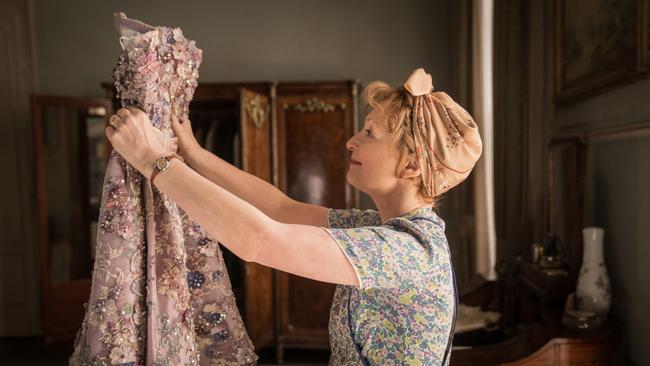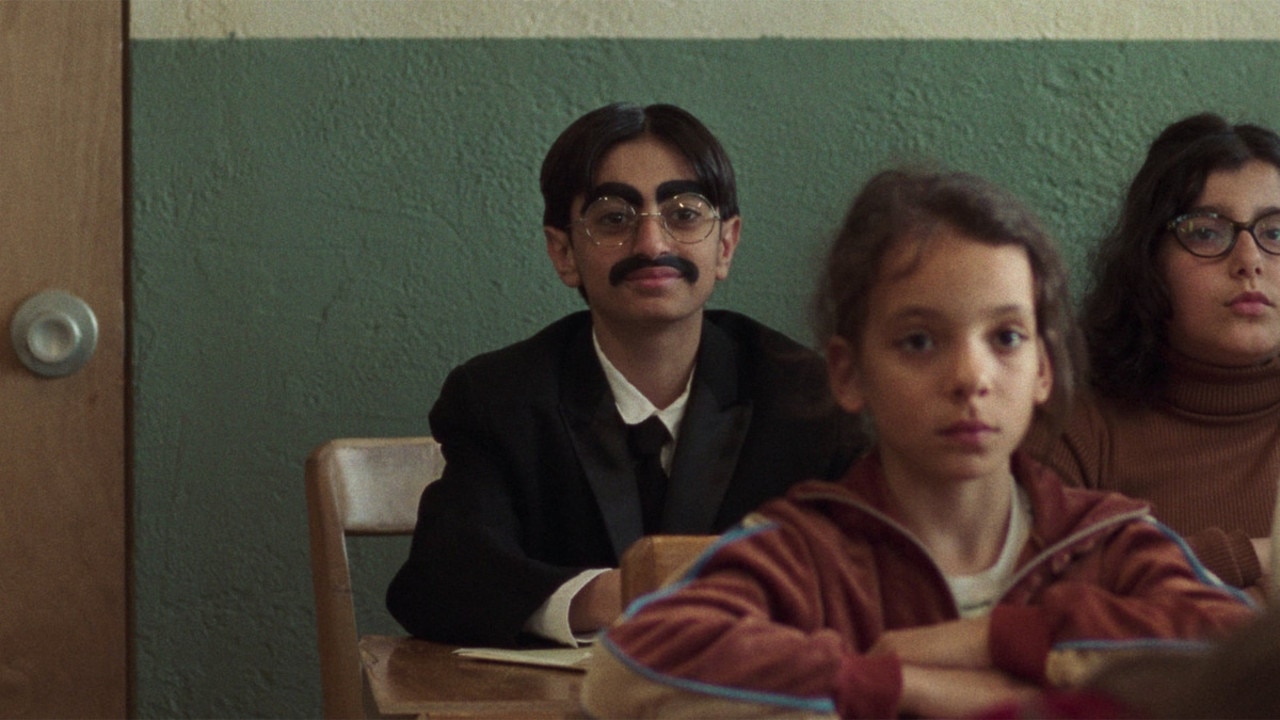Mrs Harris goes to Paris is a flight of fancy right off the rack
Lesley Manville is perfect in the title role of this film, a wistful romp through the French capital and into the heart of the nascent fashion industry

American author Paul Gallico (1897-1976) is probably best remembered for his sentimental The Snow Goose, published in 1941, or, by filmgoers, for his 1969 novel, The Poseidon Adventure, on which the successful 1974 disaster movie was based. But for me Gallico’s most engaging books are those featuring London charlady Mrs Harris. The first of these, Flowers for Mrs Harris, was published in 1958, and in America was titled Mrs ‘Arris Goes to Paris.
Anthony Fabian’s film, Mrs Harris Goes to Paris, is a faithful and affectionate adaptation of the book. Lesley Manville plays Mrs Harris to perfection; older viewers may be reminded, as I was, by the late Kathleen Harrison, an actor who played this kind of role in British films in the 40s and 50s.
The year is 1957 and Mrs H has only now received confirmation that her beloved husband was killed 12 years earlier when his plane crashed near Warsaw.
But life goes on. Mrs H and her friend Violet (Ellen Thomas) are employed cleaning the houses of the rich, including snobbish Lady Dant (Anna Chancellor), who is tardy in paying her wages yet, as Mrs H observes, thinks nothing of spending £500 on a Dior dress. Mrs H becomes fixated on buying a Dior for herself; she gambles on a greyhound race, wins the football pools, receives back payment of the war widow’s pension and eventually acquires enough money to pay for a quick flight to Paris — where, on arrival at Le Bourget airport, she apparently walks into the city centre!
At the Dior showroom she’s befriended by the urbane Marquis de Chassagne (Lambert Wilson) who helps her gain entree to Dior’s 10th anniversary fashion parade (Dior himself, briefly played by Philippe Berton, died in the year in which the film is set; his successor, Yves Saint Laurent, doesn’t rate a mention here). It turns out that the dress Mrs H chooses will take days to fit, but fortunately the company’s young accountant, Andre Fauvel (Lucas Bravo), who is secretly in love with the company’s top model, Natasha (Alba Baptista), allows the visitor from London to stay in his apartment and wear the clothes of his absent sister.
Mrs H is so generous, kind and good that everyone — except cranky Claudine Colbert (Isabelle Huppert), the company’s manager, wants to help her.
There are fascinating parallels here with the Stanley Donen’s Fred Astaire/Audrey Hepburn musical Funny Face, which was made in 1957, the year in which Mrs Harris is set, and which also takes place mostly in Paris in and around a famous fashion house, much like Dior. Like Hepburn in that film, Andre and Natasha in this one are disciples of Jean-Paul Sartre and the surrealists. Manville is perfect in the title role and the film, though fanciful, is very easy to take. Incidentally, most of it was filmed in Budapest rather than Paris.
Out of the Blue (MA15+)
Three and a half stars
In cinemas
Director Neil LaBute’s Out of the Blue taps into the classical era of film noir. Films such as Double Indemnity (1944) and Body Heat (1981) among many others have described the machinations of a femme fatale who ensnares her lover in a plot to kill an unwanted husband. The plot may be a familiar one, but in good hands it works well; and LaBute knows just what to do with it. It’s a giveaway when beautiful Marilyn (Diane Kruger) asks librarian Connor (Ray Nicholson) to recommend a crime book and he picks James M. Cain’s “The Postman Always Rings Twice”, another story about lovers who conspire to kill the woman’s husband (“Do they get away with it?” asks Marilyn).
Connor seems a likeable character, but he has served three years in prison for the accidental killing of a man at a party (“Three years for pushing someone!”) and has been out of prison for just three months. His probation officer, Jack (Hank Azaria), is a zealous watchdog with a no-holds-barred attitude - as demonstrated in a scene in a diner in which he humiliates a couple of guys who complain about the foul language he uses.
Connor meets Marilyn one fateful day when he’s out jogging. He arrives at a quiet beach just as she is emerging from the water after a swim. They chat, they flirt, and he’s hooked. Later, she comes to the library where he works and he’s overwhelmed by her beauty and provocative approach. They inevitably become lovers and, after some steamy encounters, start discussing the possibility of disposing of Marilyn’s abusive husband, Richard (Victor Slezak).
Connor, who, when at home in his apartment is invariably watching a television station that features films noir with Humphrey Bogart or Edward G. Robinson, should know better than to get into this situation; he’s seen enough movies to know how it’s all likely to end, and furthermore he could always opt for his obviously available co-worker, Kim (Gia Crovatin, doing the Annie Hall thing with glasses, waistcoat and tie), who is clearly in love with him.
Aficionados of the genre won’t expect too many surprises as the plot unfolds. Can Marilyn be trusted? What role is Jared (Keilyn Durrell James) playing in the drama, and why is Richard’s daughter, Astrid (Chase Sui Wonders) behaving the way she does? Despite the fact that a key scene is handled in a rather muddled fashion, the film, which is set in the state of Rhode Island, works very well along its familiar lines. All the performances are fine and there’s a pleasant sense of humour in the frequent use of rather curious inter-titles (Two or Three Weeks Later, Some Time After That, A Day or so Later and so on). It’s likely to be a delight for the movie buffs among us.
Everything in Between (M)
Three and a half stars
In cinemas
Filmed in Sydney’s Eastern Suburbs, Everything in Between is an interesting example of a potentially mawkish film that is redeemed by some excellent acting.
18-year-old Jason, known as Jay (Jordan Dulieu) lives with his parents, Meredith (Gigi Edgley) and David (Martin Crewes), in an opulent house. His mother is a controlling alcoholic, his father an apparently successful businessman who is unfaithful with various girlfriends. Jay is deeply unhappy and, in an early scene, is about to throw himself over a cliff into the sea when stopped by the Uber driver who brought him there.
In hospital for assessment Jay meets 28-year-old Liz Myer (Freyia Benjamin), a girl from California who is backpacking around the world. The unhappy teenager and the worldly-wise outsider form a bond, and it’s not long before Jay introduces Liz to his parents. But Liz is suffering from a fatal disease – coccidiodomycosis – and rejects all offers of help.
The plot evokes memories of the lachrymose Love Story (1970) in which Ryan O’Neal and Ali McGraw suffered through the latter character’s terminal illness - the film had the notorious tagline: “Love means never having to say you’re sorry”, which was cheerfully spoofed by O’Neal in his subsequent comedy, What’s Up Doc? (1972).
The lovers here aren’t particularly interesting, unlike the film’s treatment of the parents; the vapid, possessive Meredith turns out to have a heart of gold while the sexually predatory and brash David proves to be a genuinely kind man who offers to pay for Liz’s medical bills without any strings attached. As Liz, Benjamin evokes the young Barbara Hershey, while Dulieu is excellent as the troubled Jay, bringing surprising nuance to what could have been a routine character. Indeed, the entire film is better than you might expect, redeemed by a better-than-average screenplay (by director Nadi Sha and Grant Osborn) and by the actors.




To join the conversation, please log in. Don't have an account? Register
Join the conversation, you are commenting as Logout